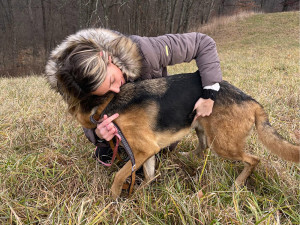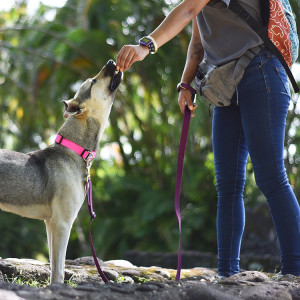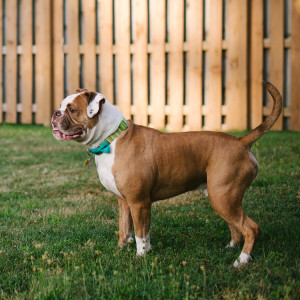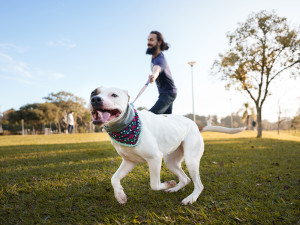You Can Use AirTags to Track Everything Now—Does That Include Your Pets?
The real question is: Should you?

Share Article
AirTags are great for keeping track of your keys or checked bags when you travel, but they are not designed for pets. Kaiann Drance, vice president of worldwide iPhone marketing at Apple, said to Fast Companyopens in new tab in April of 2021, immediately after the product was announced. Yet no sooner were AirTags introduced to the world than a secondary market popped up, adapting them for this exact purpose.
Of course, products are adapted for new and unintended purposes all the time. Bubble wrap, for instance, was originally invented as 3D wallpaperopens in new tab, while Kotex started out as wound dressingopens in new tab during Wold War I.
But just because a product can be used a certain way, doesn’t mean it should. You can use a Q-tip to clean out your ears, but you’re not supposed to. In fact, there is a warning right there on the box that says inserting a Q-tip into the ear canal can cause injury.
There are pros and cons to using AirTags.
So, when it comes to your pets, are AirTags more Kotex or Q-tip? Let’s look at some of the pros and cons.
How much do you spend on your pet per year?

Pro: AirTags are small (1.26 inches in diameter) and lightweight (11 grams).
This means they can be attached to your pet’s collar via a third party adapter without weighing them down or getting in their way.
Con: Because they are small, they can pose a choking hazard.
If swallowed, surgery could be required to retrieve them.
To reduce the risk of the AirTag detaching from your pet’s collar, use a collar with a built-in AirTag portopens in new tab or a separate AirTag holderopens in new tab that lies flush against your dog’s existing collar. You don’t want the AirTag hanging off the collar, since another dog could latch onto it during play and swallow it.
Pro: You can track your pet in real time using the Find My app.
AirTags work by pinging off nearby Apple products running the Find My app. As as long as your pet is near such a device, you should be able to find them, whether they are miles from home or just chilling in the dark recesses of the spare bedroom closet.
Con: AirTags only have a range of about 30 feet.
AirTags use bluetooth to reach out to nearby devices, so if there aren’t any devices in range, you won’t be able to find them. This means they are better suited to more densely populated areas, like big cities, as opposed to more rural locales where the devices are fewer and farther between.
GPS collar alternatives, like Whistleopens in new tab, do exist. They come with a subscription but may be a better option if you want to be able to track your pup at all times.
Pro: Evidence shows that the radiofrequency electromagnetic fields (RF-EMF) emitted by tracking devices like AirTags pose no health risk to pets.
A study published opens in new tab by the National Library of Medicine in 2021 found that pet exposure from these devices was well within healthy limits.
Con: The scientists behind the above study still recommend limiting the amount of time you keep a tracker attached to your pet.
Because AirTags emit constantly and cannot be turned off, study author Judith Klune and her team recommend only putting the trackers on your pets when there is an imminent need, like when they are going outside or when you are going out of town.
Real pet parents weigh in: should you use AirTags on your pets?
So, should you use AirTags to track your pets? It’s really up to you. There are risks, but there are also ways to mitigate those risks, as outlined above. We talked to some real pet parents who’ve tried this route to keep an eye on their pets.
“My wife and I got AirTags for our cats when we adopted them,” cat dad Jeff Warner says. “But we rarely use them anymore. Mostly just if we are traveling or have a lot of people coming in and out of the house. The last time we used them was when we took the cats to visit my mom. They are so good at hiding and the AirTags just let us know that they were still in the house.”
Alexis DiGregorio started using AirTags on her cats after moving cross country and trading an apartment for a house. “I knew the cats would be curious about the outside and I wanted a way to track them if they got out,” she says. So far, only one has actually made it past the front door, and she was quickly spotted and called back inside.
A dog dad named Frank, who asked that we not use his real name in this article, used to use an AirTag on his dog, Bill, especially when letting him off leash or leaving him with a sitter. But he switched to a GPS collar about a year ago for safety reasons.
“A neighbor of mine left her dog with a sitter, and the dog ran away,” he says. “We think she was stolen after that because we found the AirTag, but not the dog. I feel like people know what AirTags look like, so they know to get rid of them. The GPS collar is maybe harder to recognize if you don’t know what you’re looking for.”
Whether you decide to use AirTags or not, microchipping is essential. It is your first, most reliable, best line of defense if your dog or cat goes missing and finds its way into a shelter or vet. Just make sure your chip is in good working order (your vet can scan it on your next visit) and that your information is up to date with the microchip company. And if you want to use an AirTag, too, that’s your decision. Honestly, just do what you can to mitigate the risks, and you’ll probably be fine either way.
References:

Charles Manning
Charles Manning is an actor and writer based in New York City. In his free time he likes to cook, go swimming at the public pool, volunteer at the LGBTQ senior center, and foster senior and special-needs cats. His work has previously appeared in Cosmopolitan, Elle, Marie Claire, Harper’s Bazaar, Seventeen, and Nylon.
Related articles
![dog leaning on laptop while man types]()
7 Important Papers You Should Always Keep on File For Your Pet
It will be super helpful if you ever need a pet-sitter, too.
![A woman feeding her dog a treat while on a hike.]()
Why Your Dog Needs a Martingale Collar
For starters, it prevents escape, works as a training tool, and is recommended by rescue workers.
![Bulldog standing in the lawn in front of a plain wood Pickett fence]()
“How Do I Get My Dog to Stop Jumping at the Fence?”
Dog trainer Robert Haussmann’s tips for calming down a dog who’s protective of their turf.
![Man in park struggling to hold his Pitbull dog who is pulling on a leash]()
“How Do I Get My Dog to Stop Pulling on the Leash?”
Dog trainer Robert Haussmann’s tips for turning a stressful walk into a chill stroll.
![Gray and white cat walking out the door]()
Preventing Escape Artists: How to Keep Your Cat from Running Away
Your kitty’s an explorer. Just keep their expeditions indoors.






